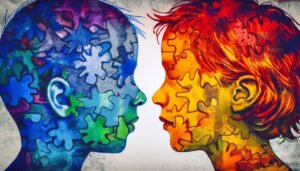Table of Contents
The Basics of Emotional Intelligence

Definition and Components
Emotional Intelligence (EI) is a concept that describes our ability to recognize, understand, and manage our own and others’ emotions. The development of Emotional Intelligence and the growing understanding in this field mark a pivotal milestone in psychology. The historical overview of Emotional Intelligence spans from the early works by Peter Salovey and John Mayer in the 1990s to Daniel Goleman, who popularized the concept with the general public.
The Pillars of Emotional Intelligence
The history of Emotional Intelligence is rich in scientific discoveries, and the evolution of Emotional Intelligence continues to flow. A central component of EI includes the five core components: self-awareness, self-regulation, motivation, empathy, and social skills.
Self-awareness is the foundation of Emotional Intelligence. It means understanding one’s own emotions, which helps in making decisions that are closely aligned with our true needs and values. Take Anna, a marketing manager. She has the ability to remain calm under pressure because she recognizes her stress response and consciously counteracts it.
Self-regulation refers to how we control and express our emotions. Someone like Thomas, a team leader, utilizes this component to give constructive feedback, instead of being overwhelmed by anger.
Motivation is the powerful inner drive that keeps us goal-oriented even in the face of setbacks, as seen with Sarah, who participates in a marathon and approaches her training with focus and optimism.
Empathy is the ability to put oneself in another’s shoes and understand their perspectives. A teacher like Mr. Müller shows empathy by recognizing and respecting the individual needs of his students.
Lastly, social skills tie all these aspects together and allow us to interact effectively and harmoniously with others. Whether in cooperation or conflict management, like Claudia, who fosters a common consensus in meetings.
The development of Emotional Intelligence is invaluable for both personal and professional success. The practical application of EI components allows us to react more balanced, improves our relationships, and fosters a positive environment in everyday life and at the workplace.
Redrawing the Emotional Map
A historical overview of Emotional Intelligence shows how influential researchers like Goleman have shaped our modern view of intelligence and success. Various studies have emphasized that EI is no less important than cognitive intelligence – sometimes even more crucial.
The approach of Emotional Intelligence is revolutionary and impacts both educational systems and the corporate world. Imagine if every employee in a company would apply their EI skills daily. The results would be teams that communicate more effectively, leaders who inspire, and corporate cultures that promote innovation.
The milestones of Emotional Intelligence teach us one thing: everyone can improve their EI and thereby enrich their lives. From interpersonal relationships to professional advancement – the ability to act with emotional intelligence is a key to personal happiness and professional success.
Measuring Emotional Intelligence
The human intellect is not only distinguished by clear analytical thinking, but also by the nuanced world of emotions. The History of Emotional Intelligence and its Development have shown that the ability to perceive, understand, and influence feelings in oneself and others is a key to personal and professional success. But how can something so complex and subjective be measured?
Scientific Tools for Measuring Emotional Intelligence
Emotional Intelligence (EI) is reflected less in IQ tests and more in specialized assessment processes. A recognized tool is the Emotional Quotient Inventory (EQ-i), designed as a multi-rater technique, meaning it allows assessment by various people. Here, aspects such as self-awareness, self-expression, interpersonal relationships, and decision-making are considered. The EQ-i is often used in business settings for personnel development.
Another important tool is the Mayer-Salovey-Caruso Emotional Intelligence Test (MSCEIT), which aims to assess emotional perception, the use of emotions to think and solve problems, understanding emotions, and their management. This test consists of a series of tasks where test subjects must identify emotions in faces, stories, and even abstract designs.
Validity and Reliability of EI Tests
Despite the complex nature of Emotional Intelligence, these instruments have proven to be valid and reliable methods for measuring EI competencies. Validity refers to the accuracy with which a test measures what it claims to measure. Reliability, on the other hand, describes how consistent test results are under the same conditions.
For example, in personnel development, the Historical Overview of Emotional Intelligence is used to design targeted EI-specific training programs and to promote leadership development. Thus, a company might offer a coaching in empathetic leadership or conflict resolution strategies based on the EQ-i results of an employee.
- The EQ-i assesses how individuals handle their own emotions and promote self-motivation.
- The MSCEIT measures the ability to use emotions and solve interpersonal problems.
- EI measurements influence the promotion of talents and leaders in companies.
The Milestones of Emotional Intelligence and the Emotional Intelligence Evolution highlight the importance of EI as a learnable and developable skill. In interpreting EI tests, it is essential not to see them as rigid measurements but as tools to identify areas that can be enhanced through targeted measures. It is this flexible application and integration of Emotional Intelligence Assessment in real contexts that shows the scientific progress and significance in practical areas such as organizational development and personnel development.
Application of Emotional Intelligence

Emotional Intelligence in Leadership and Management
Emotional Intelligence (EI) is the invisible conductor in the orchestra of human interactions, especially in the world of management and leadership. The development of Emotional Intelligence and its ongoing relevance in the modern workplace stem not only from the human desire for harmonious interaction but also from the recognition that it is a crucial factor for success.
The history of Emotional Intelligence narrates an evolution in the understanding of how our emotions shape and influence work dynamics. Milestones in Emotional Intelligence reveal that leaders with high EI tend to form teams that are not only more productive but also more satisfied. They excel at creating an environment where employees feel valued and can fully unfold their potential.
Transformative Leadership through Emotional Intelligence
Transformative leadership is a practice that goes beyond everyday management and focuses on effecting positive changes in organizations. A historical overview of Emotional Intelligence shows that transformative leaders possess high EI, which enables them to understand and positively channel the emotions of their employees. They find tones that create resonance, motivate their teams, and inspire innovations. A well-known example is that of a CEO who, through his high empathy and clear, empathetic communication skills, leads the company through difficult times of change.
Emotional Intelligence as a Decision-Making Tool
Decision-makers who consider EI often bring about more balanced and sustainable results. They enable the development of Emotional Intelligence across the entire company by understanding their own emotions and those of their colleagues, and including them in the decision-making process. This has led in many cases to decisions that are based not only on logic but also on human values, which are increasingly gaining importance in the history of Emotional Intelligence.
Emotional Intelligence in Change Management
The ongoing transformation of the business world requires leaders who master change management. A strong indicator of success in this area is again the evolution of Emotional Intelligence. Leaders with high EI are masters at communicating changes not as a threat but as an opportunity. They help employees overcome the fear of change and instead recognize and seize the opportunities it presents.
The ability to empathize with others, resolve conflicts constructively, and create an atmosphere of trust are indispensable qualities of a successful leader in a constantly changing work environment. By integrating Emotional Intelligence into leadership and management, it is possible to create an environment in which people can develop and organizations can thrive.
Emotional Intelligence in Personal Development
The History of Emotional Intelligence has taught us that how we perceive, understand, and manage our emotions significantly impacts our personal development. Through historical perspectives and the Development of Emotional Intelligence, from early theories to current models, we better understand how crucial this aspect is for effective interpersonal relationships and individual growth.
The Importance of Active Listening
A key to deepening our emotional understanding is active listening. This skill allows us not only to hear others’ words but also to recognize the emotions behind them and to respond appropriately. For example, a friend talking about work stress may actually be seeking emotional support. An emotionally intelligent listener would recognize this and could strengthen the relationship through empathy and supportive communication.
- Emotional coaching is another technique that contributes to the improvement of the Emotional Intelligence Evolution. It helps identify emotional response patterns and consciously direct them towards positive outcomes.
- Another example of applying emotional intelligence is stress management. By recognizing emotions that trigger stress and responding reflectively, we can learn to control our emotional response and thus better handle stressful situations.
- Last but not least, resilience is a milestone in the Development of Emotional Intelligence. By gaining improved insight into our own emotional states, we learn to withstand challenges and learn from them, rather than despairing.
The Practice of Emotional Intelligence
In practice, this might look like this: A leader uses active listening and emotional coaching to create a positive work environment. They encourage open communication and offer employees the opportunity to talk about emotional challenges. The result: stronger team cohesion and enhanced performance.
In building resilience, a person could, after a failed relationship, use emotional intelligence to better understand and process their feelings. Instead of wallowing in self-pity, they become aware of their strengths, learn from the experience, and face future relationships with new wisdom.
Emotional intelligence is not a fixed size but can be enhanced through continuous practice and reflection. The Historical Overview of Emotional Intelligence shows us that people who invest in this competence often lead healthier relationships, are more successful in their careers, and generally enjoy a higher quality of life. Thus, emotional intelligence proves to be an essential building block on the path to personal development and mastering everyday life challenges.
Summary
The History of Emotional Intelligence takes us on a journey that demonstrates how our understanding of emotions and their role in personal development has grown. The Development of Emotional Intelligence has been shaped by key figures such as Peter Salovey, John Mayer, and particularly Daniel Goleman, who advanced the concept in the 1990s.
What is Emotional Intelligence?
Emotional Intelligence (EI) encompasses the abilities to recognize one’s own and others’ feelings and to use this information for thoughtful and balanced actions. Five core components are crucial: self-awareness, self-regulation, motivation, empathy, and social skills. These aspects significantly influence how we make decisions, respond to challenges, and interact with others.
Self-awareness allows a clear perception of one’s own emotions, while Self-regulation builds on consciously managing those feelings. Motivation refers to the driving force that pushes us forward despite obstacles. Empathy is essential for understanding and dealing with the feelings of others, and social skills ultimately lead to successful interpersonal interactions.
Research shows that Emotional Intelligence is a critical factor for success in both private and professional areas, and the History of Emotional Intelligence places this realization in a broader historical context.
- Specialized assessment tools like the Emotional Quotient Inventory (EQ-i) and the Mayer-Salovey-Caruso Emotional Intelligence Test (MSCEIT) help to measure and understand EI.
- Programs for developing Emotional Intelligence are fundamental for building adaptive and effective teams.
- Active listening and emotional coaching are practical techniques that enhance EI and develop resilience.
The Milestones of Emotional Intelligence also highlight how EI has transformed management and leadership qualities. Transformative Leadership through Emotional Intelligence results in organizations where people feel understood and valued, the work atmosphere is positive, and changes are seen as opportunities.
Ultimately, the concept of Emotional Intelligence is essential for Change Management, as leaders with high EI can communicate and implement changes successfully. They are characterized by a profound understanding of human behavior and its impact on business success.
The Emotional Intelligence Evolution is not complete, but the History of Emotional Intelligence already offers us valuable insights. By improving our EI skills, we not only broaden our own horizons but also contribute to a stronger, more empathetic, and effective mutual cooperation in our society.
FAQ – History of Emotional Intelligence
Which key figures and studies mark crucial turning points in the development of the concept of emotional intelligence up to its present recognition?
The theory of emotional intelligence was significantly shaped by Peter Salovey and John D. Mayer in the 1990s with their groundbreaking publication, which defined emotional intelligence as a set of skills that includes the processing of emotional information. Daniel Goleman brought the concept into the mainstream in 1995 by publishing a book of the same name that highlighted emotional intelligence as a key to success in life and career and was rich in everyday examples. Subsequent research, including neurological studies and workplace analysis, has further legitimized emotional intelligence and confirmed it as an essential factor for personal and professional excellence.
What key moments mark the development of emotional intelligence from its initial concepts to its modern recognition in psychology?
The development of emotional intelligence began in 1990, when psychologists Peter Salovey and John D. Mayer coined the term and created an initial scientific basis by describing how emotions can be perceived, understood, and regulated. Daniel Goleman’s 1995 book ‘Emotional Intelligence’ introduced the concept to a broader audience and argued that emotional intelligence is as important for life success as the traditional IQ. Today, emotional intelligence is an integral part of personality psychology, with numerous research studies underscoring its significance in various areas such as leadership, education, and personal relationships.
What key publications and research findings mark the essential development stages of the theory of emotional intelligence since the 1990s?
The theory of emotional intelligence gained widespread attention with the 1995 book ‘Emotional Intelligence’ by Daniel Goleman, in which he presented the concept as a key factor for personal and professional success. Another milestone was the model developed in 1998 by John D. Mayer and Peter Salovey, which defined emotional intelligence as the ability to recognize, understand, and regulate emotions, as detailed in their publication ‘What is emotional intelligence’. Since then, numerous studies, such as ‘Emotional Intelligence 2.0’ published by Travis Bradberry and Jean Greaves in 2009, have refined the concept and provided practical strategies for developing emotional intelligence.








